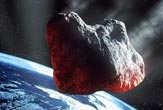A Week's Warning of Asteroid Strike Would Be Simple

An early warning system that could give Earth a week's notice or more before a space rock destroyed a city would cost only $1 million per observatory, its leading proponent suggests.
Given current technologies, this lead time would not be enough to mount a mission to deflect the incoming object, but it could be enough to evacuate the area under threat.
Astronomer John Tonry at the University of Hawaii mentioned a near-miss in 2009 as he stressed the need for an early warning system against cosmic impacts.
An asteroid the size of a bus exploded that Oct. 28 as it entered Earth's atmosphere over an isolated part of Indonesia. The burst of the 33-foot-long (10 meters) rock packed the equivalent of roughly 50,000 tons of TNT, more than three times the strength of the atomic bomb dropped on Hiroshima.
No one was reported hurt, but Tonry said objects of that size are likely to threaten Earth once per decade.
According to estimates by Tonry and other researchers, the rate of impact by asteroids at least 460 feet (140 meters) long is just once per 20,000 years or more — but the smaller the rock, the larger the risk. A roughly 160-foot-long (50 meters) object like the one that devastated the Tunguska area in Russia in 1908 is likely to impact Earth about once every millennium, while a 65- to 100-foot-long asteroid (20 to 30 meters) should strike once every century.
The National Research Council estimated a 160-foot-long object would cause an average of 30,000 deaths.
Sign up for the Live Science daily newsletter now
Get the world’s most fascinating discoveries delivered straight to your inbox.
Tonry details his analysis in a paper set to appear in the January issue of the Publications of the Astronomical Society of the Pacific.
"When it comes to something that dangerous, it just feels incumbent to me that we at least look to make sure that things are okay or not, now that we have the technology to do so," Tonry told SPACE.com. "Not looking would be like driving down a road without looking at your rearview mirror just because you've never been rear-ended before. It's nuts."
Developing a network of telescopes that can find city-destroying asteroids years in advance, giving scientists a chance to deflect them, would take decades and cost hundreds of millions of dollars. Instead, Tonry and his colleagues are suggesting a network that in many cases could give the authorities enough notice to evacuate areas. Such a network could be constructed quickly and cheaply, they say.
"The performance you can get out of modern software, modern detectors and very modest-sized telescopes is surprisingly interesting," Tonry said.
The network the researchers propose, dubbed ATLAS (for the Asteroid Terrestrial-impact Last Alert System), would consist of two observatories roughly 60 miles (100 km) apart that together would scan the visible sky twice a night. Each observatory would house four relatively small telescopes some 10 inches (25 cm) in aperture, as well as a camera for each telescope. The distance between the observatories would provide a way of separating nearby and distant moving objects, and the system would be able to help pinpoint the location and time of an impact to a few miles and a few seconds.
Each telescope and each camera would cost roughly $50,000. The software would take up the lion's share of expenses, bringing the cost for each observatory to $1 million. Tonry also projected $500,000 annually for staff, maintenance and other operating costs. He and his colleagues have submitted a $3 million proposal to NASA to build two observatories and operate them for two years.
ATLAS could provide three weeks' warning for 460-foot-long objects and one week's notice for 160-foot-long impactors. The smaller the object, the less warning there would be; a 65- to 100-foot-long asteroid might draw two or three days warning, while 33-foot-long objects might get one.
As currently proposed, ATLAS would detect more than half the impactors longer than 160 feet, and nearly two-thirds of those 460 feet long. The chances of detection go up with more telescopes, Tonry said, which would allow ATLAS to compensate for cloudy weather or lack of coverage in the Southern Hemisphere. Still, ATLAS' detection rate would never go higher than roughly 75 percent, since it could spot objects coming from the blinding direction of the sun.
Tonyy added that ATLAS could monitor changes in the sky brought on not only by asteroids, but by a wide range of phenomena: supernovas, quasars, gravitational lensing events, asteroid collisions in the main belt, variable stars, gravity waves, space junk, dwarf planets.
"We want to put ourselves in the way of discovering the unexpected," Tonry said.
The space agency is now waiting for its budget appropriations from Congress. More details on ATLAS are available at the project's site, Fallingstar.com.
- 5 Reasons to Care About Asteroids
- Will an Asteroid Hit Earth? Are We All Doomed?
- U.S. Must Be Ready to Meet Asteroid Threat, White House Science Adviser Says
This article was provided by SPACE.com, a sister site of LiveScience.com.










